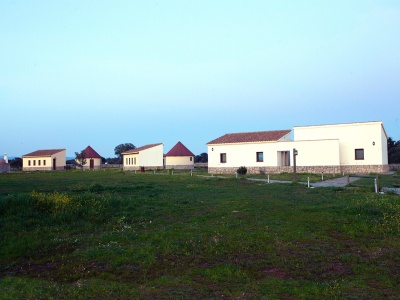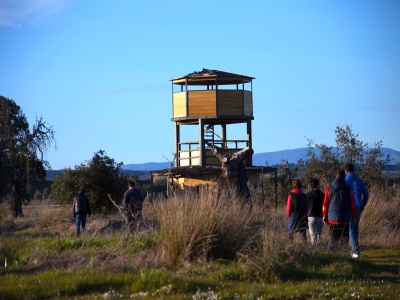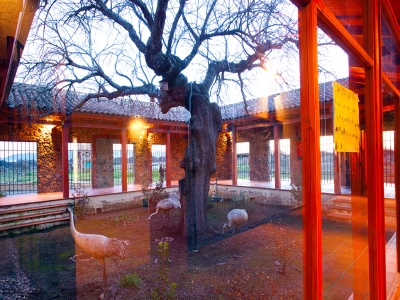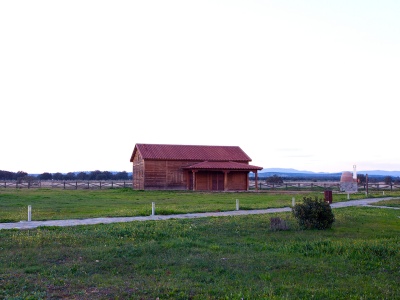Introduction
The "Moheda Alta" estate, with a surface area of 150 ha, is property of the Navalvillar de Pela (Badajoz) Town Council and was declared a Peri-urban Conservation and Leisure Park by Decree 35/2001, on the 6th of March 2001, thus joining the Network of Protected Natural Spaces of Extremadura.
The "Moheda Alta" Peri-urban Conservation and Leisure Park is located between las Vegas Altas de Guadiana and the rugged alluvial plains at the foothills of the Las Villuercas Mountains. The predominant habitats form a complex mosaic which comprises wood pastures, irrigated (rice, corn and fruit trees) and unirrigated lands (cereal and leguminous), olive groves, wooded formations along the riverside (mainly along the course of the rivers Cubilar, Ruecas and Gargáligas) and large reservoirs (Cijara, Garcia de Sola, Orellana, Gargáligas, Rucas, Cubilar and Sierra Brava). The variety of the landscape in these surroundings means the presence of numerous species of wild flora and fauna. In particular, the alternation between areas of wood pasture and irrigated lands has made it the main wintering area for the Common Crane (Grus grus) in Extremadura, hosting the most important population in the entire region and one of the most important in the Iberian Peninsula.
Interpretive Centre
The "Dehesa de Moheda Alta" Peri-urban Conservation and Leisure Park boasts an Interpretive Centre among its facilities, situated at kilometre 4.8 of the EX-116 road between Villanueva de la Serena and Guadalupe. The Interpretive Centre has been designed giving priority in its contents to the two most characteristic elements of the Peri-urban Conservation and Leisure Park: the Common Crane and wood pastures. To achieve this two thematic areas have been created where numerous panels are displayed, as well as an audiovisual area.
The "Sala de las Grullas" (Common Crane Room) boasts several thematic panels about the Common Crane which show, in detail, European migration routes, the main locations of their passage and wintering in the Iberian Peninsula and the various core sites in Extremadura, explaining in detail their features in the Moheda Alta area. The most important aspects of the biology, habitat and behaviour of the Common Crane are also covered, as is their relationship and co-existence with man.
In the "Sala de las Dehesas" the origin of dehesas, or wood pastures, human intervention in their maintenance and the traditional system of exploitation are explained, as is the importance of the faunistic and botanical value which they possess.
It boasts an "Audiovisual Room" where a video is projected based on the contents of the Interpretive Centre entitled "El Viaje de Goran ("Goran's Journey") which recreates the migration of a pair of common cranes and their chick from the Hornburg National Park (Sweden) to the wood pastures of Moheda Alta (Extremadura).
Observatories
Three observatories have been built within the "Dehesa de Moheda Alta" Peri-urban Conservation and Leisure Park to watch the daily movements of cranes, especially to see their arrival at the roosts from the feeding areas in the wood-pastures and irrigated lands. Due to its elevated position and its exceptional location, it also allows you to watch many other species of birds which are present in the area.
Hostel
A hostel run by the Navalvillar de Pela Town Council nestles among the beautiful landscape of the Moheda Alta wood pasture. It comprises 3 small rustic houses with room for 27 people and 2 traditional cabins with room for 20 more. It also boasts a bar/restaurant and other facilities such as a dining room, a wood oven and toilets and showers with hot water.
Other activities
•Guided Routes. If they so wish, and provided that there is enough time and staff available, groups of visitors can request guided routes within the Moheda Alta wood pasture.
•Digital Field Notebook. An activity which applies new technologies to enjoying and learning about nature by creating a digital field notebook.
•Censuses. During the winter, visitors will be able to participate in the censuses of the migratory species present in the vicinity of the Peri-urban Park. Censuses are usually carried out of the following species: Common Crane, Greylag Goose and other anatidae, Western Marsh Harrier, Charadriiformes, etc.





